Related Research Articles
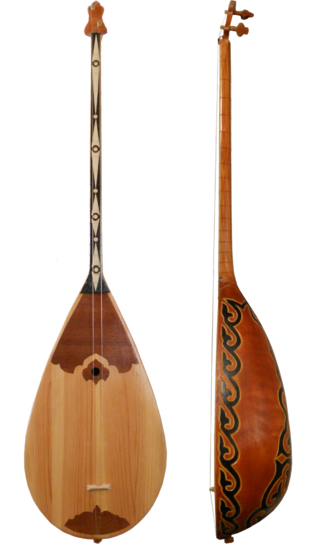
The Dombra, also known as Dombyra or Tambura is a long-necked musical string instrument used by the Kazakhs, Uzbeks, Bashkirs, Balochs and Hazaras in their traditional folk music. The Dombura shares certain characteristics with the komuz and dutar instruments, such as its long, thin neck and oblong body shape. It is a popular instrument mostly among Turkic and Iranic communities in Central Asian countries such as Kazakhstan, Uzbekistan, Tajikistan, Turkmenistan, Afghanistan and Pakistan.

A fret is any of the thin strips of material, usually metal wire, inserted laterally at specific positions along the neck or fretboard of a stringed instrument. Frets usually extend across the full width of the neck. On some historical instruments and non-European instruments, frets are made of pieces of string tied around the neck.
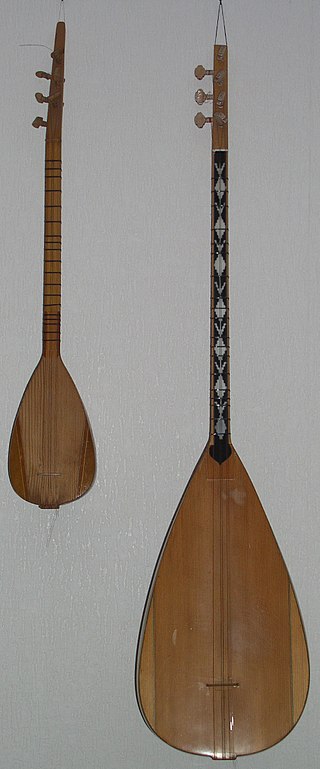
The bağlama or saz is a family of plucked string instruments, long-necked lutes used in Ottoman classical music, Turkish folk music, Turkish Arabesque music, Azerbaijani music, Kurdish music, Armenian music and in parts of Syria, Iraq and the Balkan countries.

Kumyks are a Turkic people, indigenous to Dagestan, Chechnya and North Ossetia. They are the largest Turkic people in the North Caucasus.

The komuz or qomuz is an ancient fretless string instrument used in Central Asian music, related to certain other Turkic string instruments, the Mongolian tovshuur, and the lute. The instrument can be found in Turkic ethnic groups, from China to Turkey. Forms of this instrument are used in China by the Naxi people and are called Huobusi, Hebisi , and Hunbusi.

Dagestan, officially the Republic of Dagestan, is a republic of Russia situated in the North Caucasus of Eastern Europe, along the Caspian Sea. It is located north of the Greater Caucasus, and is a part of the North Caucasian Federal District. The republic is the southernmost tip of Russia, sharing land borders with the countries of Azerbaijan and Georgia to the south and southwest, the Russian republics of Chechnya and Kalmykia to the west and north, and with Stavropol Krai to the northwest. Makhachkala is the republic's capital and largest city; other major cities are Derbent, Kizlyar, Izberbash, Kaspiysk, and Buynaksk.
Kumyk is a Turkic language spoken by about 426,212 people, mainly by the Kumyks, in the Dagestan, North Ossetia and Chechen republics of the Russian Federation. Until the 20th century Kumyk was the lingua-franca of the Northern Caucasus.

The tar is a long-necked, waisted lute family instrument, used by many cultures and countries including Iran, Azerbaijan, Uzbekistan, Armenia, Georgia, Tajikistan, Turkey, and others near the Caucasus and Central Asia regions. The older and more complete name of the tār is čāhārtār or čārtār, meaning in Persian "four string",. This is in accordance with a practice common in Persian-speaking areas of distinguishing lutes on the basis of the number of strings originally employed. Beside the čārtār, these include the dotār, setār, pančtār, and šaštār or šeštār.
The music of Central Asia is as vast and unique as the many cultures and peoples who inhabit the region. Principal instrument types are two- or three-stringed lutes, the necks either fretted or fretless; fiddles made of horsehair; flutes, mostly open at both ends and either end-blown or side-blown; and jew harps, mostly metal. Percussion instruments include frame drums, tambourines, and kettledrums. Instrumental polyphony is achieved primarily by lutes and fiddles.
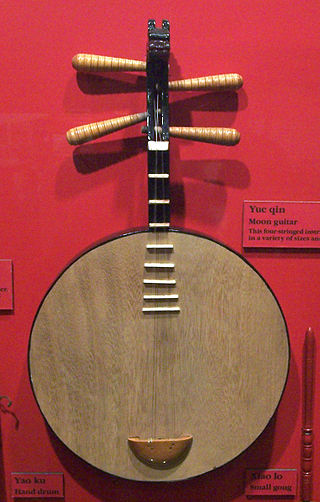
The yueqin, also called a moon lute or moon guitar, is a traditional Chinese string instrument. It is a lute with a round, hollow soundboard, a short fretted neck, and usually four strings. It is an important instrument in the Peking opera orchestra, often taking the role of main melodic instrument in lieu of the bowed string section.
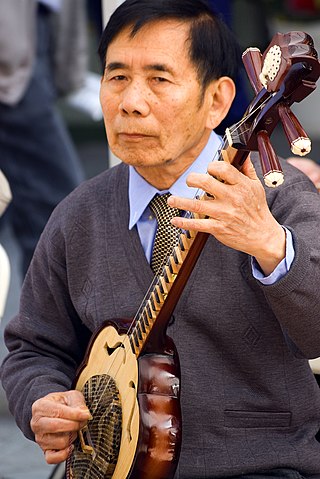
The qinqin is a plucked Chinese lute. It was originally manufactured with a wooden body, a slender fretted neck, and three strings.photo 1[ photo 2] Its body can be round,photo hexagonal, or octagonal.[ photo] Often, only two strings were used, as in certain regional silk-and-bamboo ensembles.photo In its hexagonal form, it is also referred to as meihuaqin.

The Sato is a bowed tanbur, or long-necked lute, played by performers of Central Asian classical and folk music, mainly in Uzbekistan. It has five strings. When plucked, the top string is pressed to the neck to produce a melody; the other four strings are drone strings. Frets on the neck are made of tied string. The soundboard has holes drilled in it for sound holes. It is made from mulberry wood.

The panduri is a traditional Georgian three-string plucked instrument common in all regions of Eastern Georgia: such as Pshav-Khevsureti, Tusheti, Kakheti and Kartli. The panduri is generally used to accompany solo heroic, comic and love songs, as well as dance. It is typically played by men.

The lavta is a plucked string music instrument from Istanbul.

The choghur is a plucked string musical instrument common in Azerbaijan and Georgia. It has 4 nylon strings.

The temir komuz is a Kyrgyz jaw's harp, while the komuz is a three-stringed fretless lute. As an instrument, the temir komuz is unrelated to the komuz in terms of style and structure; however, it takes its name from the other popular Turkic instrument.

The Phandar is a traditional Vainakhish three-string plucked instrument from Chechnya and Ingushetia in the Northern Caucasus.
The sound produced by the Phandar is similar to the Panduri, but it is easy to hear the difference between these two similar instruments.
The rawap or rubab is an Eastern Iranian fretted plucked long-necked stringed instrument also used in folk music by residents of the Uyghur autonomous region of Xinjiang, Western China. The history of the instrument dates back to the Ancient Iran including modern Tajikistan and spreading in the 14th century to Turkic cultures including southern Xinjiang. It is an instrument of the Tajiks also used in Uzbekistan. It's particularly associated with Tajik music and culture including Tajiks of Bukhara and Samarkand.
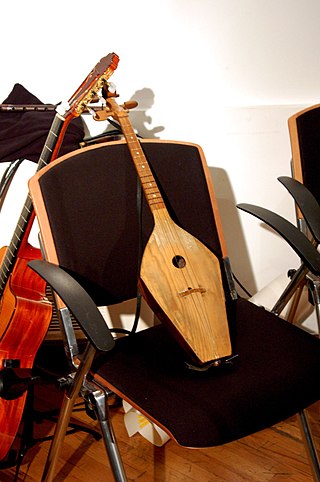
A rich variety of musical instruments are known from Georgia. Among the most popular instruments are blown instruments, like the soinari, known in Samegrelo as larchemi, stviri (flute), gudastviri (bagpipe), string instruments like changi (harp), chonguri, panduri, bowed chuniri, known also as chianuri, and a variety of drums. Georgian musical instruments are traditionally overshadowed by the rich vocal traditions of Georgia, and subsequently received much less attention from Georgian scholars. Dimitri Arakishvili and particularly Manana Shilakadze contributed to the study of musical instrument in Georgia.

The Qoltuq nagara(Armpit drum) is a folk drum with double head that is played on one side with the bare hands. It is used in Armenia, Turkey, Iranian Azerbaijanis, Azerbaijan Georgia and other Caucasus regions. It has different names, according to the territory in which it is played. This membranophone is different from the dhol and nagara of India.
References
- 1 2 Mark Slobin. Kirgiz Instrumental Music. Theodore Front Music. pp. 11–. ISBN 978-0-614-16459-6 . Retrieved 24 August 2012.
- ↑ https://stringedinstrumentdatabase.aornis.com/datumbazo/a.htm Stringed Instrument Database: A
- ↑ https://atlasofpluckedinstruments.com/middle_east.htm#dagestan Atlas of Plucked Instruments: Dagestan
- ↑ Soi︠u︡z pisateleĭ SSSR. (1973). Soviet literature. Foreign Languages Publishing House. p. 60. Retrieved 24 August 2012.